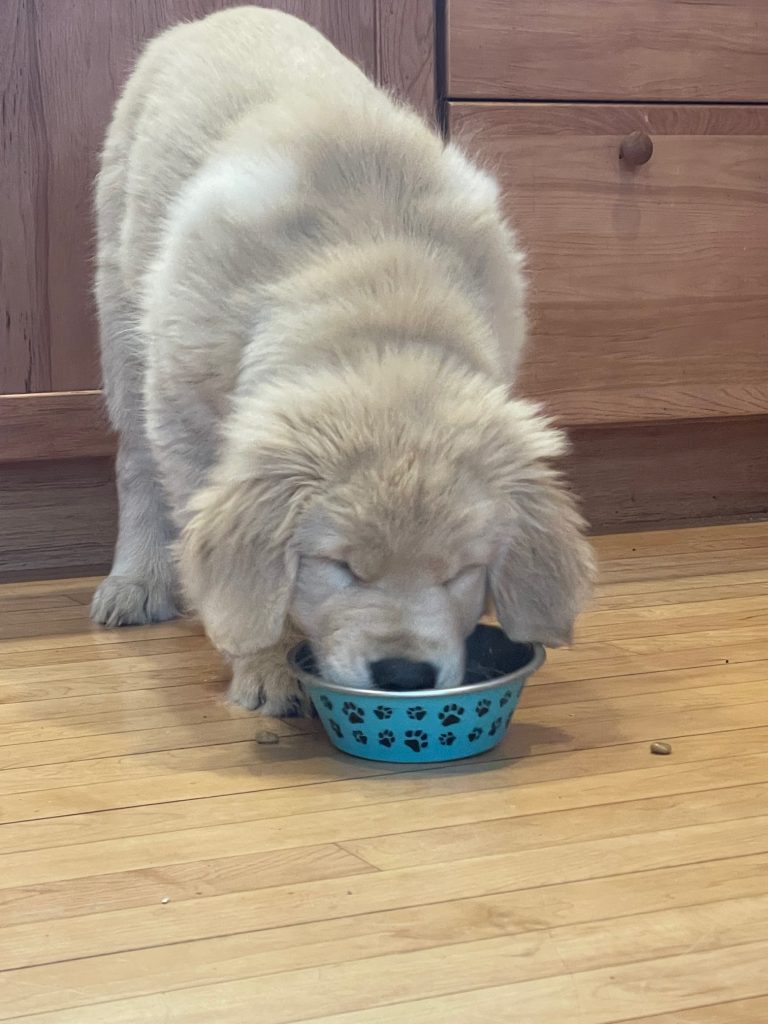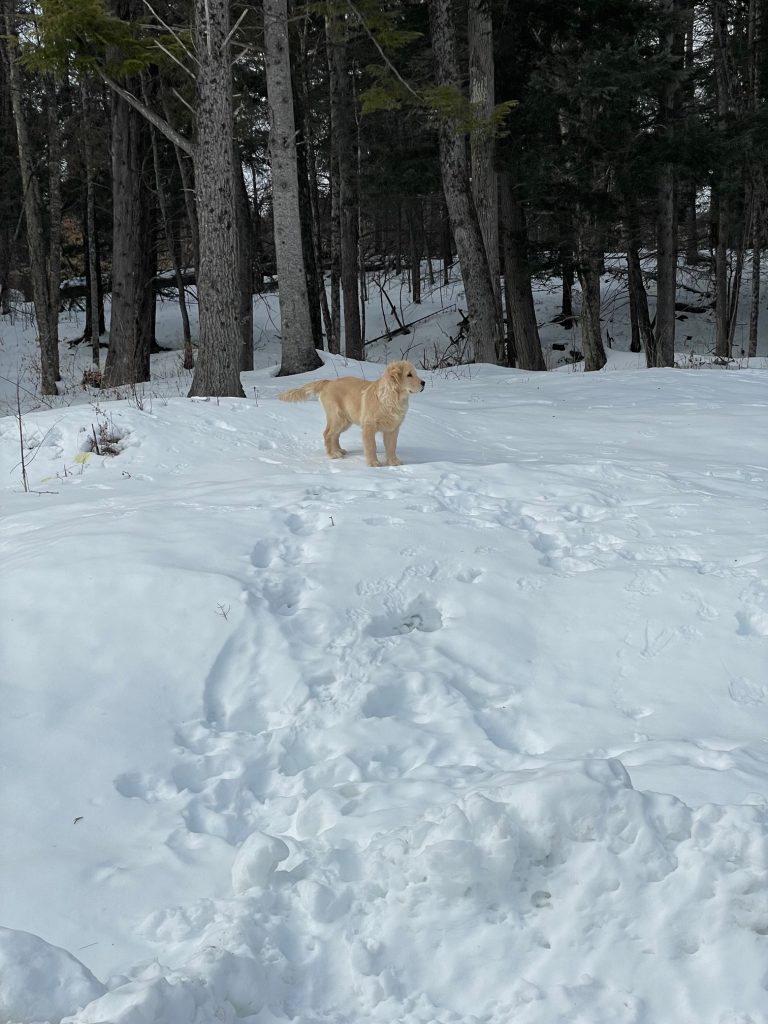Having recently lost Tulliver, my wonderful gift of devotion, and with twelve year old Kazoo showing his age, we decided to bring a new pup into our home. In our years of canine rescue work we had visited most of the breeders in our area, noting which were unscrupulous puppy mills and which were driven by a strong sense of ethics and responsibility toward the breed. As luck would have it, one of the best was getting back into breeding after a Covid-induced hiatus. Butternut Goldens was just a few miles from us.
We reached out and arranged a day to meet, liked what we saw in the five week old litter, told the breeder what we were looking for in a new family member – confidence, curiosity, and calmness – trusting her to observe the pups as they matured and narrow the field down for us.


I’m often asked, especially with our background in golden rescue, why we obtain our pups from a breeder instead of from a shelter. Afterall, some of the best dogs we’ve ever had were rescues. The short answer is time. Puppies are rare in rescue; most often dogs in shelters have a few years behind them and are often burdened by habits learned after years of neglect. It takes time to earn their trust, time to unlearn past habits. And by the time a rescue is ready to travel with me he has a pitifully short time to enjoy it. Tulliver was a classic example of that. He joined me in the sidecar at age seven, attending just two rallies before the arthritis brought on by poor breeding and extremely early neutering forced him to the sidelines. His heart was full of everything I cherished in the breed, but his body retired long before his time.


Will he be Daddy’s dog? 
Or Mama’s boy?
I held his tiny body and recited the pledge I make to all the dogs who share my life.
Little One, I promise you a life filled with love and adventure. I’ll never force you to do anything you truly don’t want to do. But should you choose to ride with me, dear God the wonders I’ll show you!

We had expected Kazoo to take the lead in puppy rearing. He had been so nurturing, so gentle with pups in the past that we gave him the title Patron Saint of Puppies. But at twelve years of age his patience had eroded; he wanted only to sleep far removed from puppy fangs. Five year old Glenlivet, my service dog and travel companion for the last three years, was insanely jealous of this fuzzy little intruder. But we’ve been through this a time or two and knew that at this stage our focus was to simply avoid injury. We’d cuddle them all, showing by that act that there was enough love to go around. Eventually they would start playing. Well, maybe not the old dog…




He ate. He played and napped. He harassed the cats. He learned that peeing and pooping outside pleased his humans, while doing so inside left them disappointed. He learned that retrieving his brothers’ frozen turds from the yard and proudly bringing them inside the house did not earn the same praise earned by retrieving toys and balls.
And he grew!
Socialization at this stage of life is critical. Talisker goes for car rides, short hikes in the forest, and gets to meet new people. Lots and lots of people! Vermont is a dog-friendly state. Add to that the fact that our tiny town is a college town with numerous young students missing the dogs they left at home – and who doesn’t love a fluffy pup! – and our little guy gets all the affection he can handle.

Puppies are adorable, and that fact goes a long way to compensating for the fact that raising them into confident, well-behaved adults is a lot of work. The first few weeks set the stage for all that will come, and those weeks are challenging for both humans as well as other dogs in the home. Talisker has been home nearly three weeks now. In that time Kazoo hasn’t interacted much, but he has come to tolerate the pup during his less frenetic periods. On walks Kazoo plods along like Shrek, while Talisker bounces at his side like Donkey. They nap together often.
Glenlivet is younger and has more play in him. Now and then I’ll see him playing with Talisker, but with limits. As I watch their reserved interaction it occurs to me that it must be difficult for a service dog like Glenlivet – utterly focused on me – to find himself having to share me with a newcomer. He doesn’t seem to realize there is enough love in this pack to share. And so I make sure to set time aside for him several times each day, to reassure him that he will always hold a special place in my heart.


At twelve weeks Talisker has entered the phase most dreaded by the older dogs: the relentless puppy fangs latching on to adult ears and tails stage. He has been corrected several times, most harshly by Kazoo, but it slows him down only temporarily. Glenlivet tolerates his attacks for a while, then leaps on top of the pup pressing him into the snow.
January 11, 2022 – a couple of days shy of fourteen weeks old – Talisker has adopted that funny adolescent look. From shoulders to hips he looks like a small dog, but the head, rump and legs are still puppyish. He runs with grace but crashes like an albatross. He is learning his basic commands but is still easily distracted by his older brothers and the cats, so we’ve shifted to solo training sessions. He is, however, entirely comfortable in our pack as evidenced by how often we find him sleeping upside down.


February 2022 – A small dog has emerged from the puppy fluff. His head has broadened a bit, his tail feathers are coming in, and he is nearly as long as Glenlivet – though his short legs and knobby knees still mark him as a youngster.

I often use three stages to describe the personality development as a pup matures. The first stage is I AM, the stage at which the pup believes the entire world revolves around his fuzzy butt. The second stage is YOU ARE, characterized by a dawning awareness that those around him are also independent units with their own needs and desires. Talisker has been in this stage for several weeks now and is still discovering the benefits – and boundaries – associated with his interactions. The last phase is WE ARE, where dog and human have completely bonded, where love and respect merge into a wonderful partnership ready to take on the world. Glenlivet is there. Talisker is working toward that goal.


April 2022: Six months old and we have a problem. Talisker has grown so fast that he appears to have developed a joint issue called osteochondritis dessicans in his left elbow. After no improvement with a week of limiting his activity, we saw our vet and got the dreaded provisional diagnosis. We see an orthopedic specialist at the end of the month for a more definitive call.
Paws crossed!


Supervising construction of the new deck 
Offering unsolicited advice





